









Fungi that are necessary for a merry Christmas









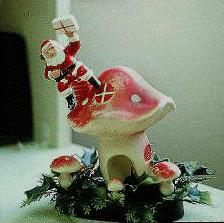 Tom Volk, Dept. of Biology, 3024 Cowley Hall, University of Wisconsin-La Crosse, La Crosse, WI 54601 USA volk.thom@uwlax.edu
Tom Volk, Dept. of Biology, 3024 Cowley Hall, University of Wisconsin-La Crosse, La Crosse, WI 54601 USA volk.thom@uwlax.edu
Return to Tom Volk's Fungi Home Page -- http://TomVolkFungi.net
This page and other pages are © Copyright 1996-2007 by Thomas J. Volk, University of Wisconsin-La Crosse
This is a companion page to another one of my pages, Fungal diseases that must be overcome to have a traditional Thanksgiving dinner and was prompted by an email from Terry Hill of Rhodes University who wrote and suggested that, on that page, I should not make fungi out to always be the villain. I agree-- there are a number of beneficial fungi, many of which are necessary for Christmas festivities. One of the major purposes for my putting up this web page is to promote the relevance of fungi to everyday life-- and to special occasions. I often use this page in my classes in introductory lectures to show the relevance of fungi in daily living. It's a whole lot more fun than a dry list of what fungi are good for.






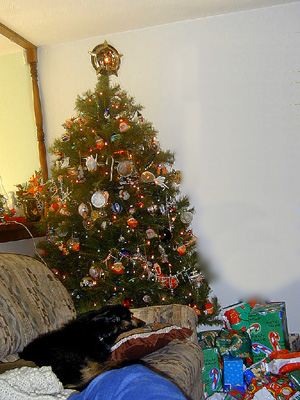
Christmas trees
The primary, although indirect, benefit of fungi to people is mycorrhizae, which are associations between fungi and the roots of plants. Approximately 90% of plant species in nature have a mycorrhizal association with a fungus! Of course the primary Christmas thing that is the direct result of this association is the Christmas tree. Without the fungi the trees would not grow very well at all-- at most a couple of feet or less than a meter tall in ten years! Most of the Christmas trees from the north (pines, firs, Douglas fir, spruces) are ectomycorrhizal-- they form an association with Basidiomycota (and a few Ascomycota), which form fruiting bodies (mushrooms) that are very familiar to most of us. Some other evergreen trees (juniper, cypress) form endomycorrhizae with microscopic members of the Glomeromycota (formerly called order Glomales of the Zygomycota), so there are never mushrooms under those kinds of trees. The fungi receive sugars from the plants' photosynthesis and, in return, the fungi provide the plants with increased absorption of water and mineral nutrients. Both the plants and the fungi benefit from this association.
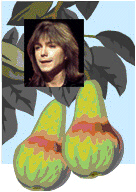 ... and while we're at it, don't forget about that partridge -- where would it sit without that endomycorrhizal pear tree? -- and where would we get our figgy pudding without that mycorrhizal Ficus tree?
... and while we're at it, don't forget about that partridge -- where would it sit without that endomycorrhizal pear tree? -- and where would we get our figgy pudding without that mycorrhizal Ficus tree?






Paper products
 The necessary and beneficial effects of mycorrhizal fungi for all trees (and almost all plants) has been noted above. Without trees there would be virtually no paper-- and no wrapping for those Christmas presents. Another fungus with potential use in the papermaking process is Phanerochaete chrysosporium, a very efficient white-rot fungus. It is being investigated as a possible biobleaching and biopulping agent to replace the harsh chemicals that are being used in conventional paper bleaching. This fungus is able to digest the brown lignin in the wood and leave the white cellulose behind for use in making paper. Phanerochaete chrysosporium is also being investigated as a possible agent of bioremediation-- the lignin degrading enzyme it produces may someday be used at toxic waste sites.
The necessary and beneficial effects of mycorrhizal fungi for all trees (and almost all plants) has been noted above. Without trees there would be virtually no paper-- and no wrapping for those Christmas presents. Another fungus with potential use in the papermaking process is Phanerochaete chrysosporium, a very efficient white-rot fungus. It is being investigated as a possible biobleaching and biopulping agent to replace the harsh chemicals that are being used in conventional paper bleaching. This fungus is able to digest the brown lignin in the wood and leave the white cellulose behind for use in making paper. Phanerochaete chrysosporium is also being investigated as a possible agent of bioremediation-- the lignin degrading enzyme it produces may someday be used at toxic waste sites.






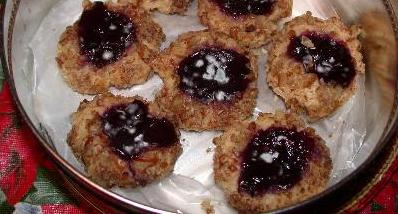
Recycling wastes
After you excitedly rip off that beautiful wrapping paper, it suddenly is transformed into waste paper, and you throw it away. What happens to it? If it goes to a landfill or dump (shame on you for not recycling), the fungi do the recycling for you. Many different kinds of fungi and bacteria degrade the paper, returning the carbon and other nutrients to the environment for other organisms to use. What about all the other waste products you make on Christmas? Those turkey bones, ham fat, "leftover" fruitcake that Aunt Louise gave you, all that dead mistletoe, reindeer droppings, and even (eventually) your Christmas tree. Fungi can degrade just about anything we can grow or make, except for most pesticides and most plastics. However, we recently published a paper, which you can access here, showing that phenolic resin plastics can be degraded by certain fungi.
So, along with the bacteria, the fungi are the major recyclers in the ecosystem, returning carbon, nitrogen phosphorous, and other elements to other organisms that need them to survive. Plants and animals both benefit, giving us something to eat on Christmas. However, sometimes the fungi get carried away-- Fungi are our main competition for christmas cookies! I suppose that's not a good thing for your Christmas celebration, but the fungi do break down the sugar, starch, and fat in the cookies. So it's probably better for your health in the long run if you let those cookies get digested by fungi. (Helpful Holiday Hint from Heloise: Always check to make sure that the powdered sugar on your cookies is not alive.)







Nuts and Chocolate
Without nuts, we would have no need for the Nutcracker Ballet! All nut trees have a mycorrhizal association with a fungus that helps them survive and prosper.
The natural bitter cocoa beans are processed into a sweet tasty candy by a "fermentation"
(sensu food-scientists) of Candida krusei and Geotrichum. Sounds yummy! In addition, cacao trees survive because they have mutualistic mycorrhizal associations with Acaulospora scrobiculata and other fungi.






 Bread and cookies
Bread and cookies
Since the world's oldest profession, after all, is baking, the fungus Saccharomyces cerevisiae (bakers' yeast) has played an important role in thousands of years of human history. It is the organism that causes dough to rise by producing carbon dioxide. The alcohol that is produced generally evaporates. In addition, Vitamin B2 (riboflavin) in enriched flour is produced by the ascomycete Ashbya gossypii.







Spirits of Christmas
Saccharomyces cerevisiae, the brewers' yeast, is necessary for wine, champagne, beer, eggnog, and other holiday spirits. They undergo anaerobic fermentation, producing ethyl alcohol and carbon dioxide, both of which are important in champagne and beer making. Of course, the alcohol is the major product in wine and the other spirits







Edible mushrooms
You can't have Christmas dinner without mushrooms! Edible mushrooms are delicious and nutritious. Many contain a protein profile (amino acids) that rivals that of beans
Most contain large amounts of B vitamins and minerals. If you're very lucky you might have some chanterelles in the freezer--- you haven't lived until you've had chanterelle stuffing in your turkey--- or maybe some dried morels or honey mushrooms. You might even be able to find or buy fresh truffles or matsutake or lobster mushrooms or blewits!!! Even if you have to settle for Agaricus bisporus, the white button mushroom, you're still doing pretty well--- but it's worth it to try some of the new cultivated varieties found in the grocery store, such as shiitake, oyster mushrooms, portabella, crimini, and enoki.
Adolf Ceska of Victoria, British Columbia, Canada has generously provided this recipe for KUBA, a traditional Bohemian Christmas treat made with Boletus edulis or some other bolete species:
KUBA
1) Dice about 5 dinner buns or kaiser buns and let the cubes dry out a little.
2) Saute about 300 g of fresh mushrooms or 30 g of dried mushrooms
(rehydrated for about 1/2 hr in water) on oil or butter and add some
caraway as a spice.
3) Wet the bun cubes with milk (don't soak them, they should be moist, not
soggy).
4) Separate yolks and whites of about 3 to 4 eggs.
5) Unite 70 - 100 g of butter with the yolks and add crushed garlic (3-4
cloves) to the mixture.
6) Mix cubes, mushrooms (wait until they are reasonably cold), butter
mixture and mix everything well.
7) Add a generous amount of marjoram to the mixture.
8) Beat the whites and "fold" them into the mixture (don't be too rough
when mixing it in).
9) Put everything into a baking dish (buttered and dusted with flour or
wheatlets) and bake it at about 375 F for about 35 minutes or until the
wooden spit remains dry when you pinch it in.
You can cut KUBA in squares and eat it hot, warm or cold. I did not
mention salt, you can use as much or as little as you want. With garlic,
caraway and marjoram (some recipes call for pepper) you have enough taste
to deal with.
|






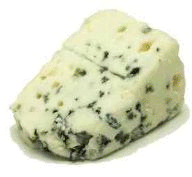
Cheese
You probably know that most cheeses are made from the action of the enzymes of certain bacteria in curdling the milk. The curds fall out of solution and are pressed together to make a block of cheese, which is then aged. Many good cheeses, such as blue cheese, camembert and brie, have an additional step; they are ripened through the action of fungi. Blue cheeses (such as Roquefort, Gorgonzola and Stilton) are ripened by Penicillium roquefortii-- the blue color is caused by sporulation of the fungus! The white crust on the outside of brie and camembert is the mycelium of Penicillium camemberti.






Antibiotics and drugs produced by fungi
 The holidays are no fun if you have a bacterial or fungal infection (such as a yeast infection or even histoplasmosis, blastomycosis, coccidioidomycosis, sporotrichosis) or other medical problems. Many antibiotics and other drugs are produced by fungi.
The holidays are no fun if you have a bacterial or fungal infection (such as a yeast infection or even histoplasmosis, blastomycosis, coccidioidomycosis, sporotrichosis) or other medical problems. Many antibiotics and other drugs are produced by fungi.
- Penicillin is one antibiotic that kills bacteria. It is produced by Penicillium chrysogenum (=P. notatum) and related species.
- Cephalosporins are another class of antibiotics produced by Cephalosporium acremonium and related species. There are about 1600 antibiotics commercially produced at least partially by fungi.
- For a fungal infection you might be taking griseofulvin, produced by Penicillium griseofulvum, or a new drug, Cilofungin, produced by Aspergillus nidulans and A. rugulosus.
- Ergotamine, produced by Claviceps purpurea, is used to facilitate delivery of babies and can also be used to relieve migraine headaches.
- The steroids in "the pill" are produced industrially by a fungus, Rhizopus nigricans, as are the steroids cortisone and prednisone.
- Lovastatin (Mevacor), the amazing cholesterol lowering drug, is produced by the fungus Aspergillus terreus.
- Compactin (Mevastatin), which also lowers cholesterol and is used in the treatment of heart disease and atherosclerosis, comes from Hypomyces, Paecilomyces, and Trichoderma.
- If you've had an organ transplant you might be taking cyclosporin, produced by the fungus Cordyceps subsessilis, also known as Tolypocladium inflatum.
- Many fungi, such as Lentinula edodes (shiitake), Grifola frondosa (maitake), Ganoderma lucidum (ling-zhi) and Cordyceps sinensis (caterpillar fungus), are used in Oriental herbal medicine to cure a wide variety of illnesses and to boost the immune system. Western medicine is just starting to examine these eastern remedies and finding that they probably do really work!







Citric acid
If we believe all the commercials on television, we could not imagine having a holiday (or any day, for that matter) without a soft drink. The citric acid in cola drinks is produced by large-scale vat fermentation of Aspergillus niger.
Maybe this should be the new logo...?

Or perhaps the catch phrase should be:
Things go better with Aspergillus TM !






Beano
 Maybe all you're having for Christmas dinner is beans. Don't laugh-- a couple years ago I was in the long line of last-minute grocery shoppers on Christmas Eve, and I watched a college student treating himself to a large can of pork and beans. That was the only thing he bought. That made me very sad to think these beans might be his special Christmas dinner. In any case, he may have had problems later with flatulence unless he took a pill called BeanoTM that contains an enzyme (b-galacatosidase) from Aspergillus terreus that reduces the flatulent abilities of beans.
Maybe all you're having for Christmas dinner is beans. Don't laugh-- a couple years ago I was in the long line of last-minute grocery shoppers on Christmas Eve, and I watched a college student treating himself to a large can of pork and beans. That was the only thing he bought. That made me very sad to think these beans might be his special Christmas dinner. In any case, he may have had problems later with flatulence unless he took a pill called BeanoTM that contains an enzyme (b-galacatosidase) from Aspergillus terreus that reduces the flatulent abilities of beans.







Stone Washed Jeans
Maybe someone bought you some soft stone-washed jeans for Christmas. Now, you didn't really think they make those variable-color, sort-of-faded-out jeans by hiring little old ladies with babushkas to take them out to the rocks on the stream and beating them? No! The jeans are placed in a large vat containing a fungus, Trichoderma, which produces enzymes (cellulases) that partially digest the cotton fibers of the jeans, for that stone-washed look and softness.






Soy sauce
 If you're celebrating Christmas with an oriental flair, as in "A Christmas Story" (one of my all-time favorite Christmas movies) you will probably have some soy sauce with and in your meal. Authentic soy sauce is fermented in a three-step process with the fungi Aspergillus oryzae and Zygosaccharomyces rouxii, as well as the bacterium Pediococcus halophilus. (Thanks to Dr. S.N. Rajagopal of the Microbiology department at UW- La Crosse for this information.)
If you're celebrating Christmas with an oriental flair, as in "A Christmas Story" (one of my all-time favorite Christmas movies) you will probably have some soy sauce with and in your meal. Authentic soy sauce is fermented in a three-step process with the fungi Aspergillus oryzae and Zygosaccharomyces rouxii, as well as the bacterium Pediococcus halophilus. (Thanks to Dr. S.N. Rajagopal of the Microbiology department at UW- La Crosse for this information.)
Interestingly, authentic Peking duck is rubbed with the red yeast Monascus purpureus to impart its coloration. Coincidentally, M. purpureus produces a cholesterol lowering drug-- so they've got a built-in antidote for the fatty cholesterol in the duck! M. purpureus is sold commercially as "red yeast rice." (Thanks to Dr. Debby Hanmer, formerly of my department, who learned this on a trip to China.)
If you're having some sake (or Shinruuchuu, a very sweet Chinese sake) with your dinner, you must thank the fungi Aspergillus oryzae (which breaks down the rice starch into sugar) and Saccharomyces cerevisiae (=Saccharomyces sake, which ferments the sugars), along with the bacterium Lactobacillus sake and perhaps other lactobacilli. (Thanks again to Dr. S.N. Rajagopal for this information.)




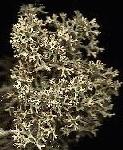
 Of course Santa's reindeer have to eat *something*, and for a large portion of the year, reindeer in the tundra feed off of reindeer lichens, Cladonia rangiferina. These are also (incorrectly) known as reindeer moss. They are very abundant in the Arctic and literally cover the tundra. Of course fungi can't take all the credit here-- a lichen is a dual organism-- the result of a mutualistic (symbiotic) relationship between a fungus and either an alga or a cyanobacterium.
Of course Santa's reindeer have to eat *something*, and for a large portion of the year, reindeer in the tundra feed off of reindeer lichens, Cladonia rangiferina. These are also (incorrectly) known as reindeer moss. They are very abundant in the Arctic and literally cover the tundra. Of course fungi can't take all the credit here-- a lichen is a dual organism-- the result of a mutualistic (symbiotic) relationship between a fungus and either an alga or a cyanobacterium.







 I hope you all have a happy holiday season!
I hope you all have a happy holiday season! 




If you have anything to add, or if you have corrections or comments, please write to me at volk.thom@uwlax.edu
This page was updated December 11, 2007
Return to Tom Volk's Fungi Home Page -- http://TomVolkFungi.net




















 Tom Volk, Dept. of Biology, 3024 Cowley Hall, University of Wisconsin-La Crosse, La Crosse, WI 54601 USA volk.thom@uwlax.edu
Tom Volk, Dept. of Biology, 3024 Cowley Hall, University of Wisconsin-La Crosse, La Crosse, WI 54601 USA volk.thom@uwlax.edu

 ... and while we're at it, don't forget about that partridge -- where would it sit without that endomycorrhizal pear tree? -- and where would we get our figgy pudding without that mycorrhizal Ficus tree?
... and while we're at it, don't forget about that partridge -- where would it sit without that endomycorrhizal pear tree? -- and where would we get our figgy pudding without that mycorrhizal Ficus tree?
 The necessary and beneficial effects of mycorrhizal fungi for all trees (and almost all plants) has been noted above. Without trees there would be virtually no paper-- and no wrapping for those Christmas presents. Another fungus with potential use in the papermaking process is Phanerochaete chrysosporium, a very efficient white-rot fungus. It is being investigated as a possible biobleaching and biopulping agent to replace the harsh chemicals that are being used in conventional paper bleaching. This fungus is able to digest the brown lignin in the wood and leave the white cellulose behind for use in making paper. Phanerochaete chrysosporium is also being investigated as a possible agent of bioremediation-- the lignin degrading enzyme it produces may someday be used at toxic waste sites.
The necessary and beneficial effects of mycorrhizal fungi for all trees (and almost all plants) has been noted above. Without trees there would be virtually no paper-- and no wrapping for those Christmas presents. Another fungus with potential use in the papermaking process is Phanerochaete chrysosporium, a very efficient white-rot fungus. It is being investigated as a possible biobleaching and biopulping agent to replace the harsh chemicals that are being used in conventional paper bleaching. This fungus is able to digest the brown lignin in the wood and leave the white cellulose behind for use in making paper. Phanerochaete chrysosporium is also being investigated as a possible agent of bioremediation-- the lignin degrading enzyme it produces may someday be used at toxic waste sites.


 Bread and cookies
Bread and cookies![]()
![]()
![]()
![]()
![]()
![]()



 The holidays are no fun if you have a bacterial or fungal infection (such as a yeast infection or even histoplasmosis, blastomycosis, coccidioidomycosis, sporotrichosis) or other medical problems. Many antibiotics and other drugs are produced by fungi.
The holidays are no fun if you have a bacterial or fungal infection (such as a yeast infection or even histoplasmosis, blastomycosis, coccidioidomycosis, sporotrichosis) or other medical problems. Many antibiotics and other drugs are produced by fungi.


 Maybe all you're having for Christmas dinner is beans. Don't laugh-- a couple years ago I was in the long line of last-minute grocery shoppers on Christmas Eve, and I watched a college student treating himself to a large can of pork and beans. That was the only thing he bought. That made me very sad to think these beans might be his special Christmas dinner. In any case, he may have had problems later with flatulence unless he took a pill called BeanoTM that contains an enzyme (b-galacatosidase) from Aspergillus terreus that reduces the flatulent abilities of beans.
Maybe all you're having for Christmas dinner is beans. Don't laugh-- a couple years ago I was in the long line of last-minute grocery shoppers on Christmas Eve, and I watched a college student treating himself to a large can of pork and beans. That was the only thing he bought. That made me very sad to think these beans might be his special Christmas dinner. In any case, he may have had problems later with flatulence unless he took a pill called BeanoTM that contains an enzyme (b-galacatosidase) from Aspergillus terreus that reduces the flatulent abilities of beans.

 If you're celebrating Christmas with an oriental flair, as in "A Christmas Story" (one of my all-time favorite Christmas movies) you will probably have some soy sauce with and in your meal. Authentic soy sauce is fermented in a three-step process with the fungi Aspergillus oryzae and Zygosaccharomyces rouxii, as well as the bacterium Pediococcus halophilus. (Thanks to Dr. S.N. Rajagopal of the Microbiology department at UW- La Crosse for this information.)
If you're celebrating Christmas with an oriental flair, as in "A Christmas Story" (one of my all-time favorite Christmas movies) you will probably have some soy sauce with and in your meal. Authentic soy sauce is fermented in a three-step process with the fungi Aspergillus oryzae and Zygosaccharomyces rouxii, as well as the bacterium Pediococcus halophilus. (Thanks to Dr. S.N. Rajagopal of the Microbiology department at UW- La Crosse for this information.)


